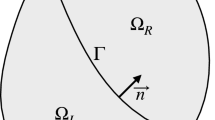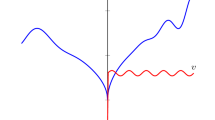Abstract
Discontinuous Galerkin finite element methods (DGFEM) offer certain advantages over standard continuous finite element methods when applied to the spatial discretisation of the acoustic wave equation. For instance, the mass matrix has a block diagonal structure which, used in conjunction with an explicit time stepping scheme, gives an extremely economical scheme for time domain simulation. This feature is ubiquitous and extends to other time-dependent wave problems such as Maxwell’s equations. An important consideration in computational wave propagation is the dispersive and dissipative properties of the discretisation scheme in comparison with those of the original system. We investigate these properties for two popular DGFEM schemes: the interior penalty discontinuous Galerkin finite element method applied to the second-order wave equation and a more general family of schemes applied to the corresponding first order system. We show how the analysis of the multi-dimensional case may be reduced to consideration of one-dimensional problems. We derive the dispersion error for various schemes and conjecture on the generalisation to higher order approximation in space
Similar content being viewed by others
References
Ainsworth M. (2004). Discrete dispersion relation for hp-version finite element approximation at high wave number. SIAM J. Numer. Anal. 42(2):553–575
Ainsworth M. (2004). Dispersive and dissipative behaviour of high order discontinuous Galerkin finite element methods. J. Comp. Phys. 198:106–130
Arnold D.N. (1982). An interior penalty finite element method with discontinuous elements. SIAM J. Numer. Anal. 19:742–760
Arnold D.N., Brezzi F., Cockburn B., and Marini L.D. (2002). Unified analysis of discontinuous Galerkin methods for elliptic problems. SIAM J. Numer. Anal. 39:1749–1779
Baker G.A. (1977). Finite element methods for elliptic equations using non-conforming elements. Math. Comput. 31:45–59
Cockburn B. (2003). Discontinuous Galerkin methods. ZAMM Z. Angew. Math. Mech. 83:731–754
Cockburn, B., Karniadakis, G., and Shu, C. W. (eds.), (2000). First International Symposium on Discontinuous Galerkin methods, volume 11 of Lecture notes in Computational Science and Engineering. Springer.
Cockburn B., and Shu C.-W. (1998). The local discontinuous Galerkin method for time-dependent convection-diffusion systems. SIAM J. Numer. Anal. 35:2440–2463
Cockburn B., and Shu C.-W. (2001). Runge-Kutta discontinuous Galerkin methods for convection-dominated problems. SIAM J. Sci. Comput. 16:193–261
Cohen G.C. (2002). Higher-order Numerical Methods for Transient Wave Equations. Springer, Berlin
Douglas J., and Dupont T. (1976). Interior Penalty Procedures for Elliptic and Hyperbolic Discontinuous Galerkin Procedures, volume 58 of Lecture notes in physics. Springer-Verlag.
Hesthaven J.S., and Warburton T. (2002). Nodal high-order methods on unstructured grids - I. Time-domain solution of Maxwell’s equations. J. Comput. Phys. 181:186–221
Hu F.Q., and Atkins H.L. (2002). Eigensolution analysis of the discontinuous Galerkin method with non-uniform grids. Part 1: One space dimension. J. Comput. Phys. 182(2):516–545
Hu, F. Q., and Atkins, H. L. (2002). Two-dimensional wave analysis of the discontinuous Galerkin method with non-uniform grids and boundary conditions. In Proc. 8th AIAA/CEAS Aeronautics Conference, Breckenridge, Colorado, June 2002. AIAA paper no. 2002–2514
Odeh F., and Keller J.B. (1964). Partial differential equations with periodic coefficients and Bloch waves in crystals. J. Math. Phys. 5:1499–504
Reed W.H., and Hill T.R. (1973). Triangular mesh methods for the neutron transport equation. Technical Report LA-UR-73-479, Los Alamos National Laboratory, Los Alamos, New Mexico, USA
Riviere, B., and Wheeler, M. (2003). Discontinuous finite element methods for acoustic and elastic wave problem. In ICM2002-Beijing Satellite Conference on Scientific Computing, volume 329 of Contemporary Mathematics, AMS, pp. 271–282
Vichnevetsky, R., and Bowles, J. B. (1982). Fourier Analysis of Numerical Approximations of Hyperbolic Equations, volume 5 of CMBS Regional Conference Series in Applied Mathematics. SIAM, Philadelphia.
Vila J.-P., and Villedieu P. (2003). Convergence of an explicit finite volume scheme for first order symmetric systems. Numer. Math. 94:573–602
Wheeler M.F. (1978). An elliptic collocation-finite element method with interior penalties. SIAM J. Numer. Anal. 15:152–161
Author information
Authors and Affiliations
Corresponding author
Rights and permissions
About this article
Cite this article
Ainsworth, M., Monk, P. & Muniz, W. Dispersive and Dissipative Properties of Discontinuous Galerkin Finite Element Methods for the Second-Order Wave Equation. J Sci Comput 27, 5–40 (2006). https://doi.org/10.1007/s10915-005-9044-x
Received:
Accepted:
Published:
Issue Date:
DOI: https://doi.org/10.1007/s10915-005-9044-x




